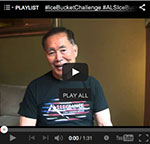fundraising
How an Ice Bucket Is Changing My Vocabulary

When I present on donor behavior I remind people that while we have an incredible array of ways to stay in touch with supporters, Americans are giving less to fewer charities. According to the 2013 VSE Report, higher education alumni donors have declined significantly over the last ten years. I like to remind myself:
A “like” is not a check.
A “click” is not a gift.
A “friend” is not a funder.
The “Ice Bucket Challenge” is revolutionary because it mixes social media, celebrity, a little peer pressure, an important cause and finally, action – in this case, the action of dumping really cold water on your head and making a video. The hope would be that supporters would take action to give as well.
They sure have given. Over $15 million by some estimates, with $10 million directly to ALSA.org.
The Challenge has generated plenty of commentary and cautionary warnings. The way I look at it, people doing goofy (but safe) things in the name of a good cause is great, provided the donations are coming in. All of this leads to a greater philanthropic public consciousness, which can only help our mission as fundraisers.
Higher Education has had its versions of the “Ice Bucket Challenge” over the past few years: Giving Days, Alumni Challenges, Crowdfunding, all geared toward getting a group of people to donate in a small time frame. The best of these have a strong social networking presence.
Unfortunately, when I’m talking with an institution about a potential challenge, some things I commonly hear are:
“If we do that, my concern is that we won’t be able to renew those donors next year.”
“Well, if they give to that, our other appeals will suffer.”
Hold up. Full stop. That’s not very donor-centric thinking. If we have a tool in our box that will encourage people to take action and make a gift, we should use it. It’s on us to show the impact of the giving, show gratitude, and follow up to convince donors to contribute again.
“Renewable and “Unrestricted.” Those are two powerful words in the world of Annual Giving. They form the bedrock upon which an annual fund stands, and have been the operating paradigm for many years. Reliable support from a donor base that you can work into the budget is the reason annual funds exist.
As we embrace new tactics that show incredible promise in getting our donors to take action, these two terms might need to be redefined.
“Renewable” might involve doing similar great things to attract at least that many donors next year, many of which should return to give again.
“Unrestricted” might start to mean continuing to fund the sort of things you’ve always funded but offering them to donors in new ways.
Consider this crowdfunding example at University of California, San Francisco.
This is incredible creative and action-driven packaging for something the annual fund at this great institution has supported forever. Research is what they do—they’re just offering the opportunity and leveraging social networks in a new way – a way that will resonate particularly with the youngest generations.
It’s time for us to more quickly embrace tactics that encourage donors to act. Giving is what we ask of donors, however the gift comes in. Working out how we count the gifts and plan for the future is our responsibility.
I’m headed to go get my bucket. And my credit card.